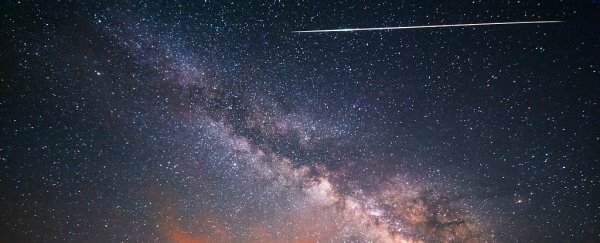We're in for quite a show over the next few weeks as Earth passes through the tail of Halley's Comet. Known as the Eta Aquarids, the month-long shower runs from April 20 to May 21, but you'll be able to see the most activity in the early hours of May 5 to 7, when the New Moon provides gloriously dark skies.
If you're up at the right times and away from light pollution, people in the Southern Hemisphere can expect to see around 30 meteors per hour streak across the night sky over the shower's peak, and those in the Northern Hemisphere will view a still-impressive 10 per hour.
Halley's Comet takes around 75 years to orbit the Sun, so we won't see the comet itself in our night skies again until mid-2061 (mark those calendars!). But every April and October, Earth moves through the comet's long tail of debris, so we still get to enjoy the light show produced when that debris burns up in our atmosphere.
This first shower is called the Eta Aquarid shower because the meteors occur in the same area of the sky as the constellation Aquarius. (In October, we experience the Orionid shower, which - you guessed it - occurs near the Orion constellation in the night sky.)
So how can you watch the Eta Aquarids? The event is going to be best viewed from the Southern Hemisphere, or by those near the equator in the Northern Hemisphere. But no matter where you are in the world, you should be able to see at least a couple of meteors light up the sky.
The best time to view will be in the early morning hours, just before the onset of morning twilight. You can find out when that happens in your area here).
You won't need to use telescopes or any other special equipment, but where you go to watch the showers makes all the difference, with the experts over at NASA recommending you get out of the city and as far from light pollution and street lights as you can.
You also need to give yourself enough time to properly enjoy the event.
"Give yourself at least an hour of viewing time for watching any meteor shower," advises EarthSky.org. "Meteors tend to come in spurts that are interspersed by lulls. Also, it can take as long as 20 minutes for your eyes to adapt to the dark."
So there you have it, pencil in May 5, 6, or 7, set your alarm really early, and pack a picnic blanket and a big thermos of coffee, because you're going to need it.
But trust us, starting your day by watching the dust trailing behind Halley's Comet burn up and fizzle as it comes into contact with Earth's atmosphere is definitely worth the early start.
